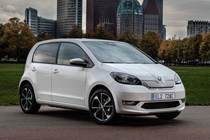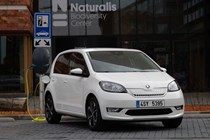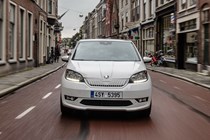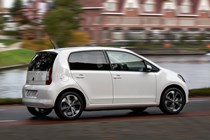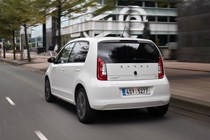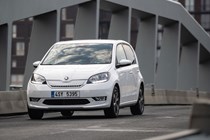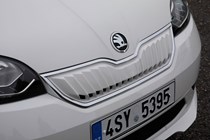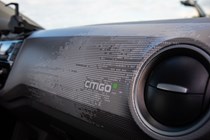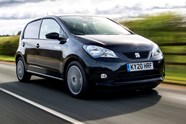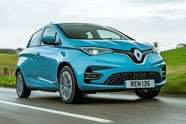
Skoda Citigo-e review

At a glance
| Price new | £20,455 - £22,815 |
|---|---|
| Used prices | £6,833 - £9,668 |
| Road tax cost | £195 |
| Insurance group | 11 - 12 |
Get an insurance quote with

|
|
| Fuel economy | Not tested to latest standards |
| Range | 140 - 170 miles |
| Number of doors | 5 |
| View full specs for a specific version | |
Available fuel types
Fully electric
Pros & cons
- One of the most affordable EVs
- Just as practical as old petrol Citigo
- Impressively nippy around town
- Very easy to use
- Some may not like the ‘normal’ feel
- Interior starting to feel dated
- Low-rent instruments
- Lacking modern infotainment
Skoda Citigo-e Hatchback rivals
Overview
Introduced in 2012, the Skoda Citigo is one of our favourite small city cars for town and city life. It’s not exciting and it’s not flash, but it’s a very well-rounded small car offering value, space, a grown-up drive and low running costs.
For 2019 though, the Citigo has undergone a big update. Not in the way it looks, but in the way it’s powered. You can now only get it in the form of the Citigo-e iV, the latter of which denotes a Skoda model that’s electrified in some way. In other words, it’s all-electric. If you want a petrol-powered Citigo, read our full review here.
Along with the SEAT Mii and Volkswagen Up, the Citigo has been updated at the end of its life and reborn as an electric city runaround that undercuts the Renault Zoe, MINI Electric and Smart EQ models in price, while still offering the same amount of practicality as the old models.
It’s a smart move, especially if this car is spending most of its time in town and buyers are moving to electric power for their second cars or runarounds. While it’s more expensive than a petrol Citigo used to be, it’s priced very competitively to steal attention away from more established electric rivals.
It’s electric, will it travel as far?
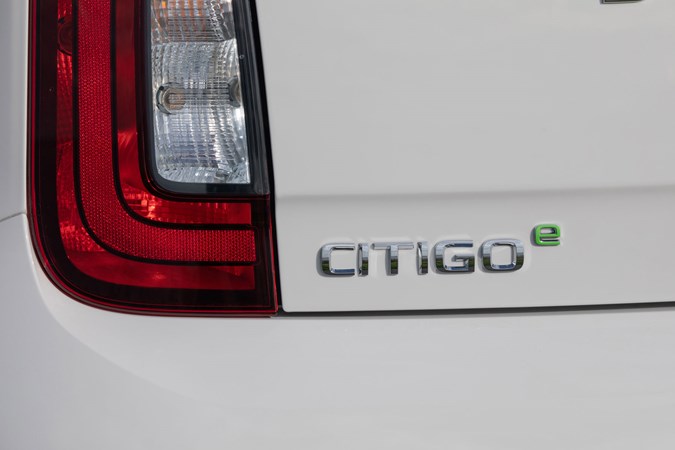
Powering the Citigo-e iV (yes, the name’s a bit of a mouthful) is a 36.8kWh battery pack that powers a 61kW electric motor. This means you’ll be able to travel for a claimed 140-170 miles on a full charge (depending on the driving mode and the way you drive it), which is less than an equivalent petrol model, but with 210Nm of torque it makes for a nippy little car in town.
If you do need more reassurance in terms of range, you’ll need to up your budget for something like a Nissan Leaf or Renault Zoe, but if you just drive around town and have the ability to charge the car at home, the Citigo is almost perfect for the job.
Go for a higher-spec SE L version of the car and it comes with a Combined Charging System (CCS) socket that allows you to charge the car to 80% in around an hour when using 40kW public rapid chargers. Alternatively, charging via a 2.3 kW household socket will take around 13 hours, while a 7.2kW AC public charging station takes four hours and 15 minutes.
What’s it like to drive?
Really rather good. We like the grown-up nature of the original Citigo, but the iV steps it up a notch, and it’s all down to the eagerness of the electric powertrain and smooth, silent running. Around town it’ll zip around easily and quietly, while its compact size and agile handling make it more fun than you’d expect it to be.
Is it still like a Citigo inside?

It is, and it’s up to you to decide if that’s a good thing or not. In keeping it simple and like the regular Citigo, Skoda’s managed to make an electric car that doesn’t feel too futuristic or intimdating to operate. There aren’t strange bongs, multiple digital displays to get confused by and weird gear selectors. There are normal analogue dials, a basic trip computer screen and a simple dash layout. You select the gear via a regular VW Group automatic shifter. Simple.
However, those looking to buy into the future of motoring by getting an electric car may see all of this as a bit of a letdown – it’s no different from an older petrol model from several years ago.
It also doesn’t have the wow factor of the Renault Zoe and it’s large portrait touchscreen and fancy materials, but we can’t really argue with what the Citigo offers when it’s available from just over £20,000 (before the £3,500 government grant) which isn’t bad for an electric vehicle (the Zoe is about £5,000 more).
The best news is that it’s retained the spacious interior. The battery pack is located beneath the rear seats, so you get the same 250-litre boot making it one of the more practical city cars out there. Plus, it’s only available in five-door form so you get greater access to the surprisingly roomy rear seats too.
Read on for the full review of the Skoda Citigo-e iV.


